Plas Newydd (Anglesey)
| Plas Newydd | |
|---|---|
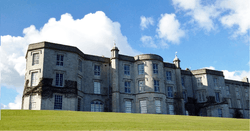 | |
| Type | House |
| Location | Llanfairpwllgwyngyll, Anglesey |
| Coordinates | 53°12′09″N 4°12′58″W / 53.2026°N 4.216°WCoordinates: 53°12′09″N 4°12′58″W / 53.2026°N 4.216°W |
| Built | 14C-16C. Substantial additions from 1751 |
| Rebuilt | 1793 |
| Architect | James Wyatt and Joseph Potter |
| Architectural style(s) | neo-classical with early gothick |
| Owner | National Trust |
Listed Building – Grade I | |
| Official name: Plas Newydd | |
| Designated | 1968 |
| Reference no. | 5462[1] |
| Official name: Plas Newydd | |
| Type | Grade I |
| Designated | 2002 |
| Reference no. | PGW (Gd) 33 (ANG)[2] |
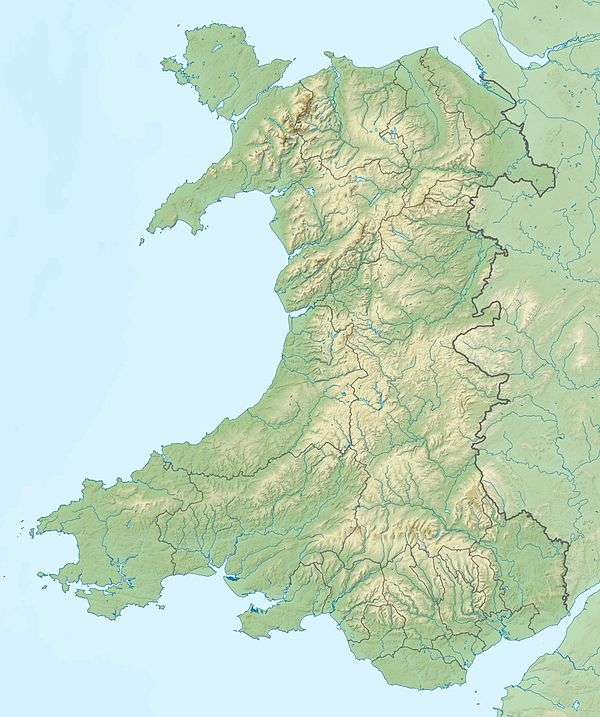 Location of Plas Newydd in Wales | |
Plas Newydd is a country house set in gardens, parkland and surrounding woodland on the north bank of the Menai Strait, in Llanddaniel Fab, near Llanfairpwllgwyngyll, Anglesey, Wales. The current building has its origins in 1470, and evolved over the centuries to become one of Anglesey's principal residences. Owned successively by Griffiths, Baylys and Pagets, it became the country seat of the Marquesses of Anglesey, and the core of a large agricultural estate. The house and grounds, with views over the strait and Snowdonia, are open to the public, having been owned by the National Trust since 1976.
History
From its earliest known resident in 1470, Plas Newydd passed by inheritance and marriage through 500 years of a family's increasing concentration of wealth, titles and estates, until the 7th Marquis of Anglesey presented it to the National Trust, so the house and grounds could be opened to the public.
Origins
The house site was first occupied in the 13th century, and was known as Llwyn-y-Moel. By 1470 it belonged to the Griffith family, who also owned Penrhyn Castle near Bangor.[3] Gwilym ap Griffith had acquired substantial Anglesey holding from his marriage to Morfydd, daughter of Goronwy ap Tudur of Penmynydd.[3] Robert Griffith built the earliest parts of the current house in the early 16th century, creating a hall-house.[2]
Bagnall and Bayly families
In 1533 Ellen Griffith married Nicholas Bagenal and they took possession of what was still known as Llwyn-y-Moel. Their granddaughter Ann married Lewis Bayly, Bishop of Bangor.[3] It was Lewis Bayly who made the first major additions to the house, and was the first to call it Plas Newydd (Welsh for New Hall).[3] The Baylys lived in Plas Newydd, along with other estates, particularly in Ireland, and Lewis's grandson Edward Bayly acquired an Irish baronetcy in 1730, when he was styled Baronet of Plas Newydd in the County of Anglesey and Mount Bagenall in the County of Down.[4] Lewis's great-grandson, Sir Nicholas Bayly, 2nd Baronet married Caroline Paget in 1737, and became Lord Lieutenant of Anglesey in 1761, a post his family would fill for the next 100 years. Their son, Henry, was to be the beneficiary of substantial inheritances from both sides of the family.
Bayly to Paget
Born in 1744 as Henry Bayly, he succeeded, through his mother, to the title and estates of the Barony of Paget in 1769, on the death of Henry Paget, 8th Baron Paget and Earl of Uxbridge, a distant cousin on his mother's side. As 9th Baron Paget, Henry Bayly took possession of the Beaudesert estates in Staffordshire, and changed his surname to Paget. (Unlike the Barony, an Earldom could not pass through the female line, so the Earldom of Uxbridge became extinct.) In 1782 his father died, which added '3rd Baronet' to his titles, and Plas Newydd to his estates.[5] He also took over as Lord Lieutenant of Anglesey. In 1784 he was made Earl of Uxbridge as a second creation of that Earldom. Extensions of Plas Newydd had been made in the middle of the 18th century, with an octagonal tower at the south-east corner, but under the Henry's care, substantial additions and rebuilding was made throughout the estate, especially with the appointment of James Wyatt and Joseph Potter as architects.
Earls of Uxbridge to Marquises of Anglesey
Plas Newydd itself was greatly altered in the 18th century by James Wyatt who refaced it, blended the towers into the building front, and substantially made it into the building that stands today. He also had constructed the large gothic style stable block which is now part of the Conway Centre, and various lodges and gateways were constructed. In 1812 Henry died and the estate passed to his son Henry William Paget, who became the 2nd Earl of Uxbridge. Henry William had raised a regiment of volunteers in the 1790s, was commissioned into the Army in 1795, and distinguished himself in numerous engagements and campaigns across Europe. By 1802 he was a major-general, and in 1815 was appointed cavalry commander, leading a spectacular charge of the British heavy cavalry at the Battle of Waterloo. In recognition of his heroism he was created the first Marquess of Anglesey, although he lost a leg from one of the last cannon shots of the day.[6] The following year the 27 metre column was raised in his honour, sited to the north of Plas Newydd.[7]
At the end of the 19th century the 5th Marquess had the chapel turned into a theatre. Plays were put on regularly, with the Marquess often taking the lead role himself. After the 6th Marquess inherited the estate, all the furniture was sold to help restore the solvency of the family after the 5th Marquess' huge spending. The family also sold off their main home at Beaudesert and their London house and moved into Plas Newydd permanently.[8] The 6th Marquess made the final big changes to the house by removing the crenellations from the roof, disposing of the theatre, knocking three servants' rooms together to make the dining room and covering over a courtyard to provide a roof for the servants. In the 1930s the artist Rex Whistler was a regular visitor to Plas Newydd. He painted numerous portraits of Lady Caroline Paget, and in 1936-38 painted the largest canvas painting in the UK.[9] It is a trompe-l'oeil seascape painting that fills a whole wall of the dining room with an imagined scene of Italianate churches, castles, Snowdonian mountains and a complete harbour wall, with tricks of perspective that mean the scenes appear to change when seen from different parts of the room.[10]

The house has been owned by the National Trust since 1976.[11] There is now a tearoom and a second-hand bookshop, and historical cruises along the Menai start from the house. The first Marquess's artificial leg is part of an exhibition.
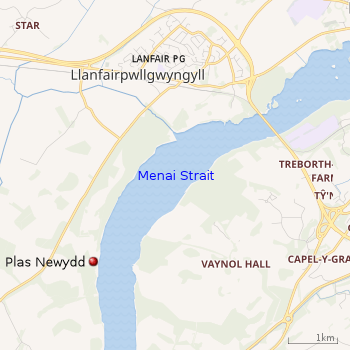 [Full screen]
|
HMS Conway
In 1949 the training ship HMS Conway was moored in the Menai Strait near Plas Newydd. The ship was supported from the small dock in the grounds of the estate. The ship was wrecked after running aground in 1953, and the school built temporary facilities in the grounds near the current reception centre. These were used for teaching and housing the senior cadets. The younger cadets were accommodated in the eastern wing of the house. The former stables building was used for teacher accommodation, classrooms and a laboratory. These arrangements continued until 1964 when the entire school moved into a new purpose-built building in the grounds of the estate. The school was closed in 1974 but the buildings and the grounds were subsequently acquired by Cheshire County Council. It was renamed the Conway Centre and is now managed by a stand-alone organisation, Quality Learning Partners,[12] with the support of Cheshire West and Chester Council, and is used as an outdoor adventure centre.[13]
Points of interest

The house contains Rex Whistler’s largest painting, measuring 58 by 12 feet (17.7 by 3.7 m).
The 7th Marquess of Anglesey retained rooms at the house until his death in July 2013.[14] Lady Rose McLaren grew up at the house along with the 7th Marquess - her brother. The 8th Marquess no longer lives at the house.
At the house there is also a military museum which contains campaign relics belonging to the 1st Marquess of Anglesey, mementos of the Battle of Waterloo and the Anglesey Leg.
Parkland and gardens
The house is set within an outstanding park, landscaped at the turn of eighteenth and nineteenth centuries.[2] The design included input from Humphry Repton, and his trademark Red Book of before and after landscape views is still extant. With its extensive waterside site, superb location, and views of the Menai Strait and Snowdonia, it is the only Anglesey site to be classed as Grade I in the Cadw/ICOMOS Register of Parks and Gardens of Special Historic Interest in Wales. It is within the Anglesey Area of Outstanding Natural Beauty and is within an Environmentally sensitive area.[2]
In January 2010, the grounds became the first part of North Wales to be included in Google Street View, thanks to a scheme to include National Trust properties by using the Google Trike where vehicular access is limited.[15]
Scheduled monuments
There are two prehistoric scheduled monuments on the site. Neither of them is directly accessible to the public, although they can both be seen. The two monuments formed a single entry in the first Ancient Monuments Act in 1882, and so along with two other Welsh monuments, were among the first to receive legal protection.
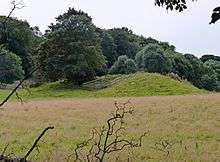
Plas Newydd Burial Chambers are two adjoining stone chambers of a Neolithic burial cairn or cromlech. They stand on private lawns in front of the house.[16]
Bryn-yr-Hen-Bobl Burial Chamber (the 'Hill of the old people') is a substantial mound with a stone chamber, to the south of the parkland. Bones were found here in 1754. It was excavated by W J Hemp in 1929-35, and Neolithic pottery appeared to lie under and in front of the mound, suggesting a settlement predating its use as a burial site. The chamber was given a doorway following the dig, but is not accessible to the public. It is visible from the southern edge of 'Garden Wood'.[17]
Listed buildings on Plas Newydd Estate
In addition to the grade I listed main house, Plas Newydd had a vast estate covering 3,848 hectares (9,510 acres) including outlying properties. The main estate lands stretched from the Grand Lodge in the north to Llanedwen in the south, taking in a further to 20 listed buildings and structures in the estate grounds.
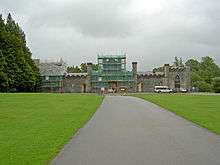
North of the House
- Entrance archways, at Grand Lodge
- grade II listed 1805 stone arches with octagonal turrets, designed by Joseph Potter as part of a major rebuild of the 1st Marquiss's park and estate buildings. It stands at the extreme north end of the estate, leading to the grand drive which ran 1 mile (1.6 km) across the park to Plas Newydd house.[18]
- Grand Lodge of Plas Newydd
- grade II listed mid-19th century lodge in a gothick style matching the earlier entrance arches.[19] (A matching lodge on the old A5 was built by Lord Clarence Paget, 4th son of the First Marquess,[20] for his house, Plas Llanfair, which later became the Training Ship Indefatigable, a lower ranks counterpart to HMS Conway, the Navy officer training facility at Plas Newydd.[21])
- Victoria Cottages
- grade II listed, built in 1832 on Brynsiencyn Road as a school which merged with the Plas Newydd Charity School in 1851 by 1872 the National School at Llanfairpwll meant it was no longer needed, and it was converted into estate workers' cottages.[22]
- Tyddyn Pwyth
- grade II listed farmhouse of longhouse plan, which fronted onto Brynsiencyn Road. In the mid-19th century was converted in a row of 3 estate workers' cottages.[23]
- Stables of Plas Newydd
- grade II listed stable block north of the main house, designed by Wyatt and Potter and completed by 1800 to accommodate 2 carriages and 14 horses. It is now part of the Conway Centre[24] and which also houses the heat-pump used to heat the main house.
- Druid Lodge
- grade II listed gamekeeper's cottage reworked in an Arts and Crafts style in 1914 and used as a laundry for the big house.[25]
East of the House
- Sea Wall and harbour facing the Menai Strait
-
.jpeg) Marine walk, c.1840, by T.G.Dutton
Marine walk, c.1840, by T.G.Dutton
grade II listed retaining wall built between 1796 and 1819, it was probably designed by Wyatt and Potter for Lord Uxbridge. Although always an ornamental feature, it sets a distinctly military tone to the sea wall. The five cannons ('trunnion' Carronades) date to around 1830-45, and are from Fort Belan, at the southeastern tip of the Menai Strait. They were given by Lord Newborough as a wedding present to Lord and Lady Anglesey in 1948.[26]
- Boathouse
- grade II listed boathouse, built shortly after the sea wall, in 1817 to 1822, alongside the harbour. It originally had five doorways at the front, three of which are now windows. It is now used by the Conway Centre.[27]
West of the House
- Old Dairy of Plas Newydd
- grade II listed stone-faced dairy buildings, were either built as part of the early 19th century works designed by Potter[2] or under the improvements in the late 19th century.[28] A central milking parlour, with wings creating three sides of a courtyard, now National trust tea rooms, shop, and visitor facilities.
- West Lodge
- grade II listed two-story stone lodge with a large double-height bay window facing the north-west access drive (now the drive to the Conway Centre). It was built in 1884 to a design by R Giles of Derby.[29]
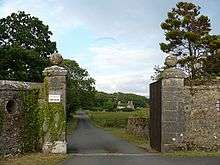
Llanedwen, south of the House
Parts of the settlement of Llanedwen, including the church, lie within the parkland of Plas Newydd. Home Farm, Plas Llanedwen and the Church have two entrance gateways and lodge buildings, off the road that forms the estate's south-western boundary.
- Plas Llanedwen
- grade II listed 17th century house, substantially extended during the 18th and early 19th centuries, and with battlemented parapets.It was described in 1846 as 'The prettiest house on the island', to which Princess Victoria had been a regular visitor.[30] The house may be where Morus Gruffydd lived in the mid-16th century, and thus be an original focus of the estate.[2]
- Church of St. Edwen
- grade II listed church, an ancient church site, completely rebuilt in 1856 to a design by the Bangor architect Henry Kennedy by the 2nd Marquis, two years after he succeeded to the title.[31]
- Llanedwen Church Lodge
- one of a pair of grade II listed Arts and Crafts style lodges, built in 1914 during the time of the 6th Marquis, but before he made Plas Newydd his main residence in 1920.[32]
- Church Lodge entrance walls and gatepiers
- grade II listed wall and gateway, built in 1914, at the same time as the lodge.[33]
- Home Farm
- grade II listed farm buildings close to Plas Llanedwen, forming three sides of a courtyard. Built in around 1804 to a design by Joseph Potter, it replaced an earlier home farm that had been much nearer the big house, and was moved on the advice of Humphry Repton.[34]
- Farm Lodge
- grade II listed Arts and Crafts style lodge near the entrance to the Home Farm, and built in 1914 for estate workers.[35]
- Farm Lodge entrance walls and gate piers
- grade II listed wall and gateway, built in 1914, providing access to both Plas Llanedwen and Home Farm. The lodge and gates match the Church lodge and gates, further down the road, with stone pillars capped by large stone balls.[36]
- Walls of square enclosed garden[37]
- very large rectangular enclosed garden[38]
- Apple House
- [39] Three grade II listed farm store, adjoining the garden features close to Home Farm. They were all built in the early 19th century, at the same time as Home Farm was moved to this part of the estate. The larger walled garden grew vegetables, with the adjoining walled orchard for fruit, which was stored in the apple house. Covering a total of 4.5 acres (1.8 ha) they were a key productive part of the estate, and were a significant expansion from the earlier walled garden near the stable block at the other end of the park.
Heat source
The National Trust has invested £600,000 for a marine source heat pump for the house.[40][41][42] At 300 kilowatts, the pump is to be the biggest in Britain.[41] Its oil-fired boiler made the mansion the most polluting[40] and biggest oil consumer[41] of the National Trust's properties;[40] the renovation is expected to save around £40,000 a year in operating costs.[40] Plas Newydd is one of five properties in a pilot experiment;[40][41] if they succeed, the National Trust will invest in 43 more renewable energy plans.[40][41] The pilot programme includes: biomass in Croft Castle in Herefordshire, a woodchip boiler in Ickworth in Suffolk, and hydroelectric projects in Hafod y Porth near Craflwyn in Snowdonia,[43] and at Stickle Ghyll in the Lake District.[40][41]
See also
- List of National Trust properties in Wales
- Grade I listed buildings in Anglesey
- List of Scheduled Monuments in Anglesey
References
- ↑ www.britishlistedbuildings.co.uk/wa-5462
- 1 2 3 4 5 6 "Plas Newydd". Cadw/ICOMOS Register of Parks and Gardens of Special Historic Interest in Wales. Cadw. Retrieved 8 March 2016.
- 1 2 3 4 www.archivewales.org.uk Bangor University: Plas Newydd Manuscripts - Context Ref: GB 0222 PN
- ↑ thepeerage.com Sir Nicholas Bayly, 2nd Bt.
- ↑ thepeerage.com Henry Paget, 1st Earl of Uxbridge
- ↑ "Plas Newydd, Anglesey, UK". BBC. Retrieved 7 August 2014.
- ↑ llanfairpwllgwyngyllgogerychwyrndrobwllllantysiliogogogoch.co.uk/column
- ↑ www.britishlistedbuildings.co.uk/en-430391 Beaudesert Hall Remains
- ↑ National trust feature: Talented young artist at Plas Newydd
- ↑ Standpoint Magzine: Book review of 'In Search of Rex Whistler' by Hugh and Mirabel Cecil, 2013
- ↑ Web page for plas-newydd-country-house-and-gardens at the National Trust website
- ↑ "Quality Learning Partners". Retrieved 1 August 2015.
- ↑ "Welcome to Conway Centres: Anglesey". Cheshire West and Cheshire. 2015. Retrieved 1 August 2015.
- ↑ The Telegraph- Obituary of The 7th Marquis of Anglesey
- ↑ National Trust sites
- ↑ Plas Newydd Burial Chambers (ID NPRN93829). at the Royal Commission on the Ancient and Historical Monuments of Wales (RCAHMW). GAT PRN: 2171. The Cadw SAM Number is AN005
- ↑ Bryn-yr-Hen-Bobl Burial Chamber (ID NPRN300180). at the Royal Commission on the Ancient and Historical Monuments of Wales (RCAHMW). GAT PRN: 2172. The Cadw SAM Number is AN006.
- ↑ British Listed Buildings: wa-5457 - Entrance archways, at Grand Lodge, listed 1968
- ↑ British Listed Buildings: wa-5458 - Grand Lodge of Plas Newydd, listed 1968
- ↑ British Listed Buildings: wa-5457 - White Lodge, listed 1998
- ↑ Nuffield Centre: A short history of the country house Plas Llanfair and of the training centre ‘Indefatigable’, accessed 17 March 2016
- ↑ British Listed Buildings: wa-5467 - Victoria Cottages, listed 1998
- ↑ British Listed Buildings: wa-5466 - yddyn Pwyth, listed 1998
- ↑ British Listed Buildings: wa-5459 - Stables of Plas Newydd, listed 1968
- ↑ British Listed Buildings: wa-19737 - Druid Lodge, listed 1998
- ↑ British Listed Buildings: wa-5463 - Retaining wall with small jetty in Menai Strait
- ↑ British Listed Buildings: wa-19729 - Stables of Plas Newydd, listed 1968
- ↑ British Listed Buildings: wa-5460 - Old Dairy, listed 1968
- ↑ British Listed Buildings: wa-19738 - West Lodge, listed 1998
- ↑ British Listed Buildings: wa-19734 - Plas Llanedwen, listed 1998
- ↑ British Listed Buildings: wa-19743 - St Edwen's Church, listed 1998
- ↑ British Listed Buildings: wa-19756 - Llanedwen Church Lodge, listed 1998
- ↑ British Listed Buildings: wa-19756 - Church Lodge entrance walls and gatepiers, listed 1998
- ↑ British Listed Buildings: wa-19730- Home Farm, listed 1998
- ↑ British Listed Buildings: wa-19748 - Farm Lodge, listed 1998
- ↑ British Listed Buildings: wa-19755 - Farm Lodge entrance walls and gate piers, listed 1998
- ↑ British Listed Buildings: wa-19731 - square enclosed garden, listed 1998
- ↑ British Listed Buildings: wa-19733 - Large rectangular enclosed garden, listed 1998
- ↑ British Listed Buildings: wa-19732 - Apple House, listed 1998
- 1 2 3 4 5 6 7 Plas Newydd: Heat from the sea to warm historic house, Roger Harrabin BBC environment analyst
- 1 2 3 4 5 6 Ocean to provide green heat source for 300-year-old mansion in Wales -The Guardian
- ↑ Country stately home to be heated by sea water The Telegraph
- ↑ Snowdonia Planning and Access Committee 11 December 2013, Snowdonia National Park Authority

